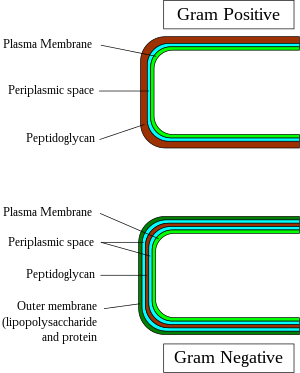
Gram-positive- and negative bacteria are chiefly differentiated by their
cell wall structure.
Gram-negative bacteria are bacteria that do not retain crystal violet dye in staining. In a Gram stain test, a counterstain, safranin, is added after the crystal violet. This colours all gram-negative bacteria with a red or pink colour.
This happens because an outer membrane stops the penetration of the stain. The test itself is useful in classifying two distinct types of bacteria based on the structural differences of their bacterial cell walls. Gram-positive bacteria retain the crystal violet dye when washed in a decolourizing solution. Compared with gram-positive bacteria, gram-negative bacteria are more resistant against antibiotics, because of their relatively impermeable cell wall.